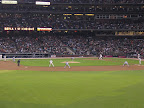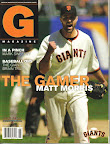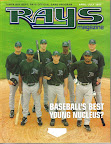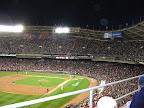June 5, 2006
Giants 14, Marlins 2
W: Noah Lowry
L: Brian Moehler
HR: Josh Willingham (FLA), Barry Bonds (SF)
Attendance: 34,438
Time of Game: 2 hours, 39 minutes
Stadium Facts
Location: San Francisco, CA
First Game: April 11, 2000
Capacity: 41,503
Type: Open
Surface: Grass
After a ridiculously long hiatus, I am finally back to chronicling my trips to every MLB stadium. I should have enough free time coming up to get through the rest of these before the winter is over. Anyway, I left off following the first stop of my California trip. I went to a game in Oakland on a Sunday afternoon in early June of 2006. The following day, I crossed the bay and spent most of the day in the fun city of San Francisco. I walked all over downtown San Fran and even walked across the Golden Gate Bridge. Eventually, I found my way to AT&T Park, home of the San Francisco Giants.
I will start by saying that if I was forced to pick my favorite MLB stadium, I would probably go with AT&T Park. This park has it all. It is in a scenic location by the San Francisco Bay, on the edge of downtown San Francisco. The stadium runs right up against the bay, with just a narrow walkway separating it from the water. Pedestrians on that walkway can see into the park through the arches along the right field wall. During the summer, many people will take kayaks out on the water in hopes of having a home run ball come their way. That area, known as McCovey's Cove, was especially popular during the Barry Bonds era as he chased down the all-time home run record.
AT&T Park has had a variety of names in its decade history. Originally Pacific Bell Park, and later SBC Park, it received its current name in 2006, the season I visited. Opened in 2000, it was the first privately funded stadium to be built in 40 years. Like most of the stadiums built in this era, it has a classic ballpark look with all the modern amenities. The brick exterior and right field wall give the park a very classic feel. The lower level seats are right on top of the playing field. The upper deck seats provide a spectacular view of the bay as well as the rolling hills on the other side. A giant Coca-Cola bottle and glove are distinctive features beyond the left field seats.
In addition to the great scenery, location and amenities, I also love the layout of the field. There are a number of nooks and crannies along the right field wall. Although Barry Bonds often made the park look small, it is actually a tremendous pitchers park, particularly to right field. While Bonds used to hit balls into McCovey's Cove with regularity, not many other guys have done the same. The deep dimensions give outfielders a lot of ground to cover, but there are very few cheap home runs. This park rewards good pitching and defense. This is quite different than most other newer parks that reward marginal power hitters.
I wound up getting a ticket for the left field bleachers, which gave me a close up view of Barry Bonds patrolling left field. It was a pretty nice afternoon in San Francisco, but got very chilly when the sun went down. I was shivering in the late innings, even though I came prepared with a sweatshirt. I imagine cool summer evenings are fairly common in the Bay Area.
As expected, Bonds reception at AT&T Park was much different than I was accustomed to seeing elsewhere. They loved him in San Francisco, although it should be noted that this game was prior to the hard evidence of Bonds' alleged steroid use that has come out in recent years. Going into this game, Bonds was sitting on 715 career home runs. About a week prior to this game, he hit #715 to pass Babe Ruth for second on the all-time home run list. So, unfortunately, I just missed a chance to see a historic moment. However, Bonds didn't disappoint the fans in this game.
Noah Lowry got the start on the mound for the Giants. The lowly Marlins went with Brian Moehler, the first of two games I would see him pitch on this trip. It was a long evening for the visiting team. The Giants got things rolling in the bottom of the second. Following a pair of singles and a sacrifice, Randy Winn socked a triple to right field and scored on an errant throw to make it 3-0. Josh Willingham gave the Marlins a boost with a leadoff home run in the fourth, but it was all Giants after that.
In the bottom of the fifth, the Giants loaded the bases with three consecutive singles. Lance Niekro promptly unloaded them with a bases clearing triple to give the Giants a 6-1 lead and set the stage for Bonds. Bonds followed with a bomb to straight away center field, landing over the wall for career home run #716. I did not see Bonds play a ton of games in his career, but he seemed to hit a home run in most of them. This one chased Moehler from the game, with the Giants already ahead 8-1. The Giants added their sixth run of the inning on a single by Todd Greene.
With the game well in hand, the Giants relieved Lowry in the sixth. The Giants put together another huge inning in the bottom of the eighth. Six singles led to five more runs, including another RBI for Winn and Niekro. Niekro set a new career high with four RBIs in this game. By the time the inning was over, the Giants had two touchdowns on the board. The Marlins scratched out a run in the ninth to lose by a final of 14-2. It wasn't much of a game, but it was an exciting night.
The Marlins were really struggling at this time with a depleted roster. They dropped to 20-35 with this loss, but bounced back in the second half under rookie manager Joe Girardi. This wound up being Girardi's only season with the Marlins following a late season dispute with Marlins management. Meanwhile, the Giants improved to 30-27, but found themselves in third place. That is exactly where they finished the season, though they slumped to a sub .500 record.
AT&T Park is one of the "must see" parks in Major League Baseball. It has everything you could possibly want in a stadium. This park and game were probably the highlight of a very fun trip. San Francisco is a pretty cool city too. I would like to spend a little more time there sometime in the future. After a few days in the Bay Area, I started my trek to Southern California the following day.
Photo Album
 |
| From San Francisco |
 |
| From San Francisco |
 |
| From San Francisco |
 |
| From San Francisco |
 |
| From San Francisco |
.JPG) |
| From San Francisco |
.JPG) |
| From San Francisco |
Next stadium: Dodger Stadium, Los Angeles





.JPG)
.JPG)





.JPG)
.JPG)





.JPG)
.JPG)






.JPG)











.JPG)
.JPG)





.JPG)
.JPG)